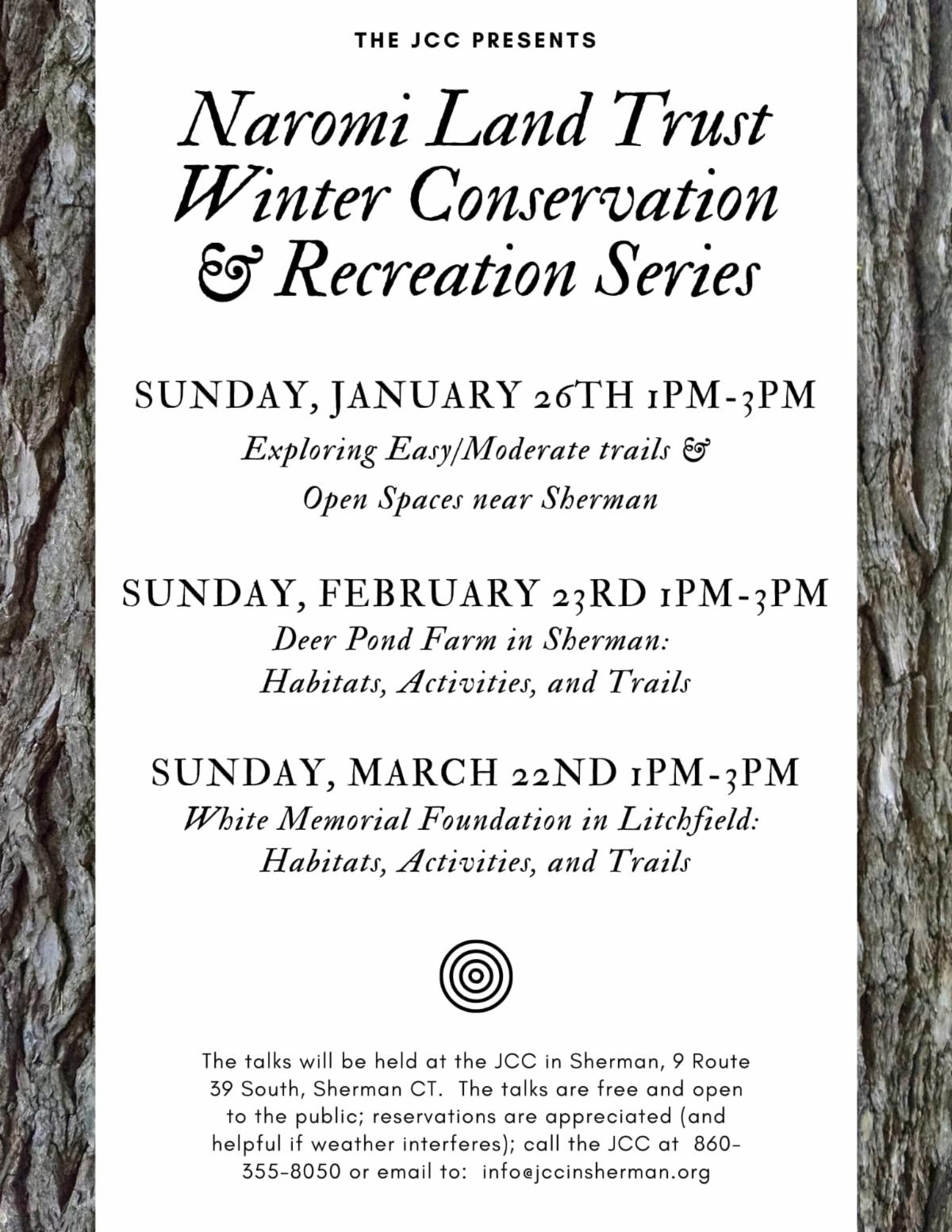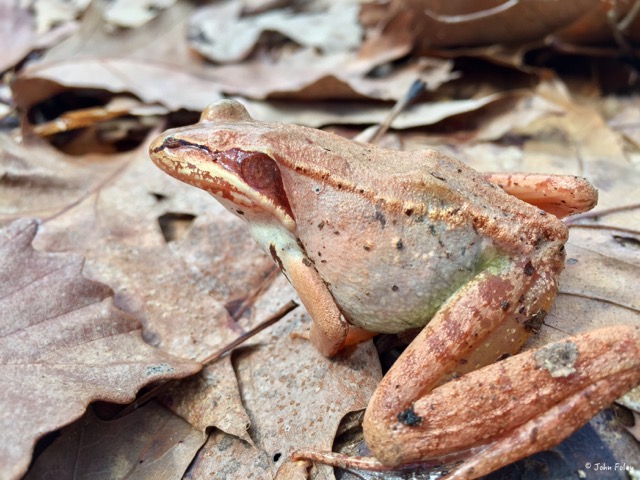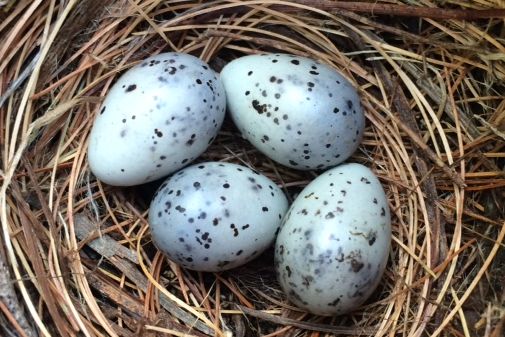|
|
|
Icy Sawmill Brook (from a previous, more winter-y winter!) - Photo by Amy Smith
|
|
|
|
|
Support Naromi
|
Don't forget to log into Amazon Smile BEFORE you shop!
Make Naromi your charity of choice through Amazon.
|
|
|
|
Members, Friends and Neighbors,
|
|
Believe it or not, it is now winter and the calendar, the lack of snow and ice, and the warm sun have us beginning to think about spring. Is winter over? Is spring upon us now? Or will March be the month when winter happens? That is how it played out for the previous two winters. Last year was the second hottest on record. Local land conservation is an important tool in climate change resilience. Forests and open lands absorb carbon dioxide emissions. Connecting critical habitats through strategic conservation is one of the best ways to support the movement of wildlife, including birds, insects and mammals, and help them to remain as resilient as possible in a changing world. Thank you for supporting Naromi so we can continue to work to achieve our strategic conservation goals.
Given the unpredictability of the winter to spring transition, we have not nailed down dates for our spring amphibian events in March and April with our wonderful partners Great Hollow Nature Preserve and Deer Pond Farm. We will keep you posted on that scheduling through this eNews and through our partners, but send us an email if you are interested in getting very late-breaking notices of any night or day hikes.
In addition, we have an exciting line-up of programming including our Conservation & Recreation series with the JCC in Sherman (be sure to check out the second of three talks, taking place this weekend), a bird walk in May, and of course, Trails Day hikes (yes - two!) in June.
I also want to thank volunteers Jim and Noah Wistman and Joel Bruzinski for helping us to keep our trails open throughout the year. They have been out clearing downed trees at the West Briggs Hill, Mallory, Herrick and Josephson Preserves in the past couple months. Thank you!!
Yours truly,
Amanda Branson
Executive Director
|
|
|
|
|
Winter Conservation & Recreation Series
|
Naromi Land Trust is presenting a winter series of inside talks about the nearby (within 45 minutes of Sherman) outside places we all can enjoy. Come and learn where there are hiking trails, rail trails for walking and biking, kayaking places, and more.
An interactive version of the map presented by Marge Josephson at the first event is available here.
Our series continues this Sunday with a talk by the CT Audubon Society's Deer Pond Farm director, Cathy Hagadorn, who will share an overview of the history, habitats and activities of our newest nature sanctuary. Cathy will highlight birding, nature and hiking activities available year round. She will also cover recent habitat enhancement projects including bird and pollinator friendly garden and shrub plantings. 
Sun. Feb 23: Deer Pond Farm in Sherman: Habitats, Activities, and Trails
Sun. Mar 22: White Memorial Foundation in Litchfield: Habitats, Activities, and Trails
The talks are held from 1pm - 3pm. The talks will be held at the JCC in Sherman, 9 Route 39 South, Sherman CT. The talks are free and open to the public; reservations are appreciated (and helpful if weather interferes); call the JCC at 860-355-8050 or email to: [email protected].
|
Spring is on its way...
|
 And that means, our annual amphibian and vernal pool trifecta of events! Naromi Land Trust, Great Hollow Nature Preserve, and CT Audubon will be co-hosting this year's events. And that means, our annual amphibian and vernal pool trifecta of events! Naromi Land Trust, Great Hollow Nature Preserve, and CT Audubon will be co-hosting this year's events.
This walk is
weather dependent. We need to be sure that our amphibious friends are awake and have begun their spring ritual.
Stay tuned for a Vernal Pool presentation and Night Hike led by John Foley of Great Hollow and a day time Frog Frolic at Naromi's Towner Hill Preserve with John and Jim Arrigoni from CT Audubon.
|
Cedar Waxwings
|
 Cedar Waxwings are year-round residents in Sherman. They love fruiting trees near forest edges and near streams. You can attract them to your yard by planting native fruit bearing trees and shrubs like winterberry (like in Dennis' photo below) and dogwood, and to your feeders by putting out fruit on platform type feeders. As always, be mindful of bear activity around your feeders. Cedar Waxwings are year-round residents in Sherman. They love fruiting trees near forest edges and near streams. You can attract them to your yard by planting native fruit bearing trees and shrubs like winterberry (like in Dennis' photo below) and dogwood, and to your feeders by putting out fruit on platform type feeders. As always, be mindful of bear activity around your feeders.
|
|
Jumping Worms?!
|
If worms make you squeamish, you may want to stop reading...
Invasive jumping worms have made appearances in Connecticut, according to the News-Times.
The Audubon Society explains:
"Earthworms found in U.S. soils today are mostly invaders from Europe, but in the last few decades more than a dozen species of jumping worms-a more destructive group from Asia used as bait or in commercial mulch-have spread. In the 1990s, scientists began documenting their damage to forests in Southern Appalachia, the Northeast, and Oregon....Once let loose, jumping worm invasions are hard to contain. Where most European worm species move about 30 feet per year, jumping worms can easily cover 17 acres, or roughly the size of 13 football fields, of new ground in a single season...According to Scott Loss, a conservation biologist at Oklahoma State University, the spread of jumping worms could exacerbate the impact other invasive earthworms have already had on forests in eastern and Midwest forests. 
'It's like stepping on the gas pedal to decomposition,' Loss says. 'Earthworms simplify what would otherwise be distinct [soil] layers. They mix that up and turn an otherwise diverse soil structure into a homogeneous mass.' Jumping worms have a particular talent for leaf processing. Unlike their European counterparts which burrow deep beneath the forest floor, jumping worms stay on the surface, rapidly consuming leaf litter and turning the once cohesive mass of soil into tiny crumbles that easily erode. One study found that jumping worms can eliminate up to 95 percent of leaf litter in the forests they invade. As a result, organic matter in this layer doesn't have a chance to decompose and return its nutrients to the terrain. In this altered soil it's difficult for the goblin ferns and asters that line healthy forest floors to take root, Loss says." (Source)
Unfortunately, their consumption interferes with the ground-nesting process for some birds and reduce populations of salamanders and millipedes.
So this spring, be sure to check your mulch and fishing bait to limit the spread of these pests. If you find a jumping worm or other invasive species, you can share your findings on iMapInvasives.
|
|
|
|
| |
|